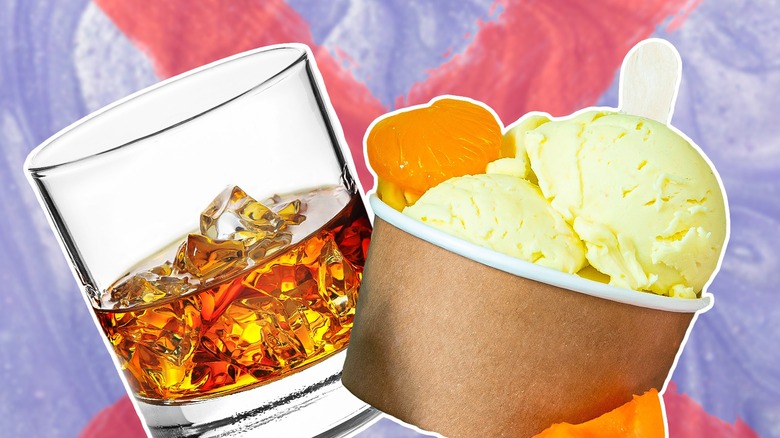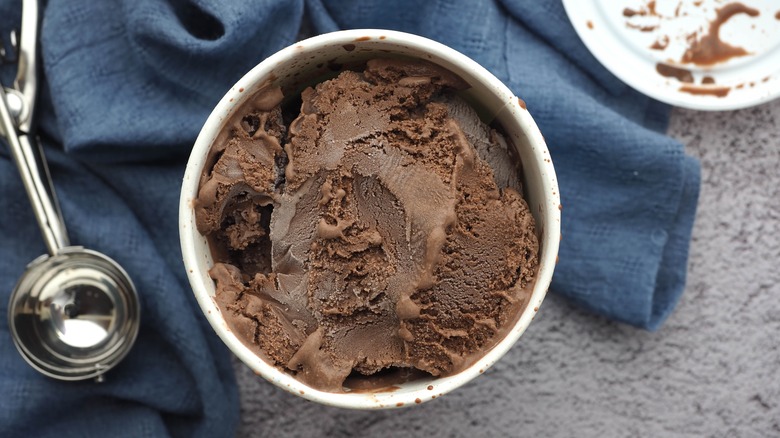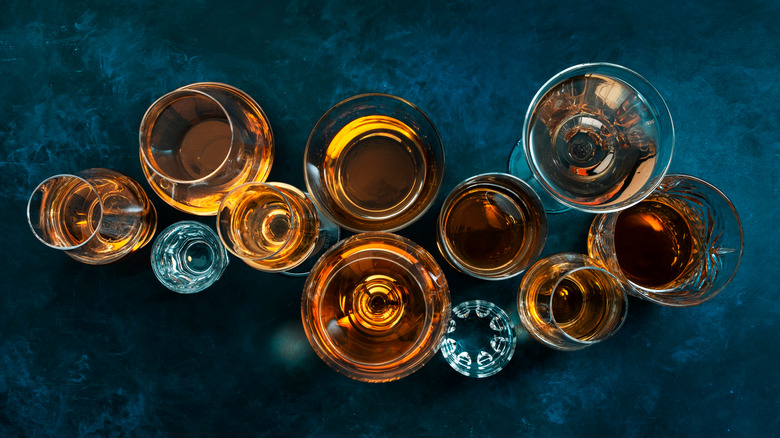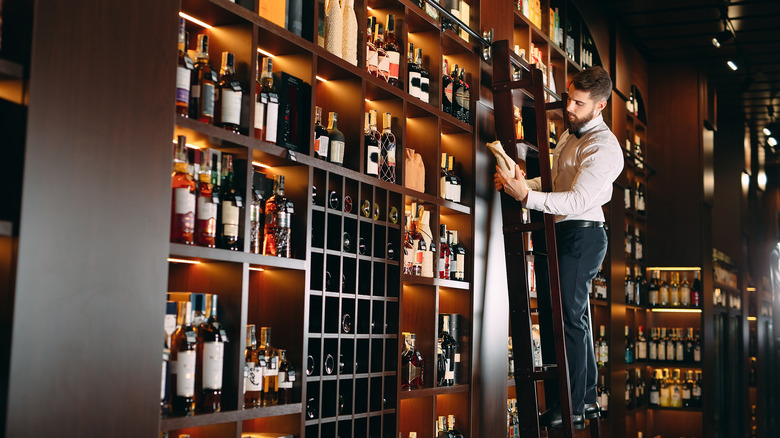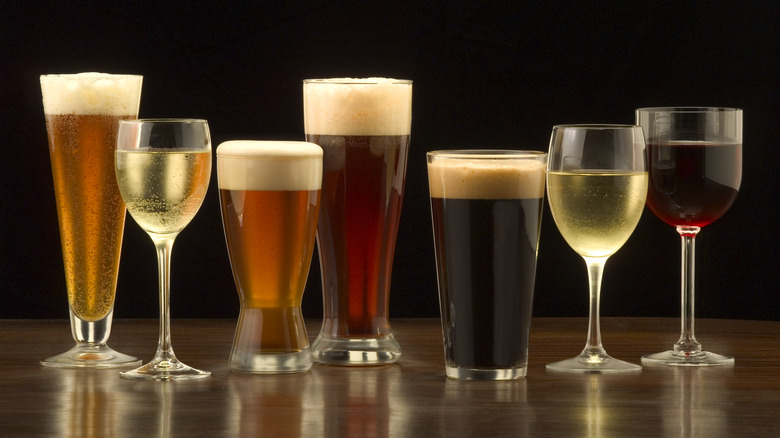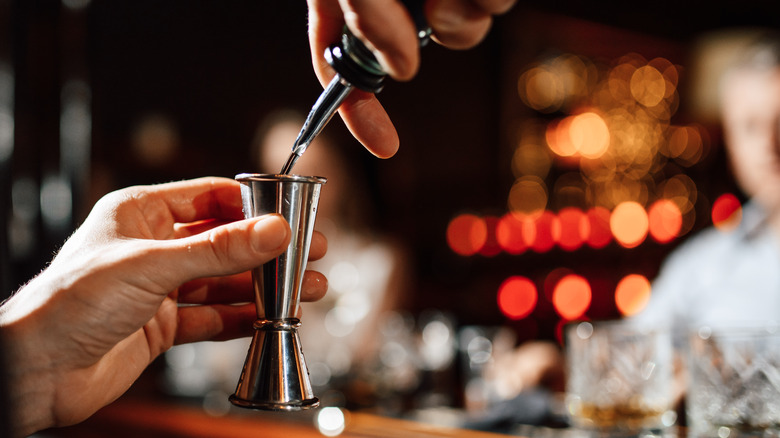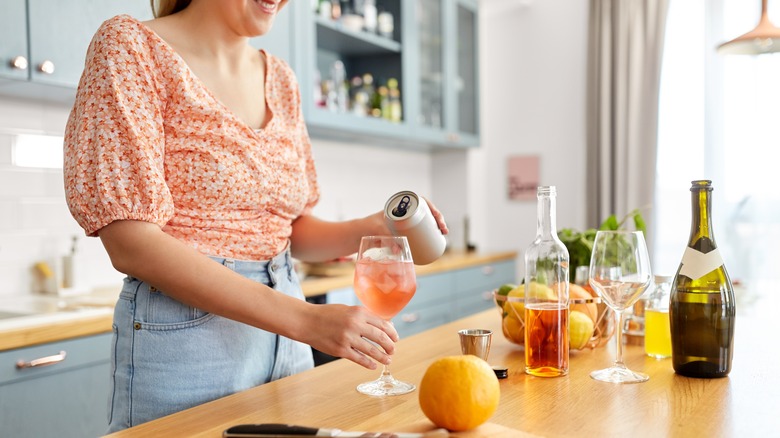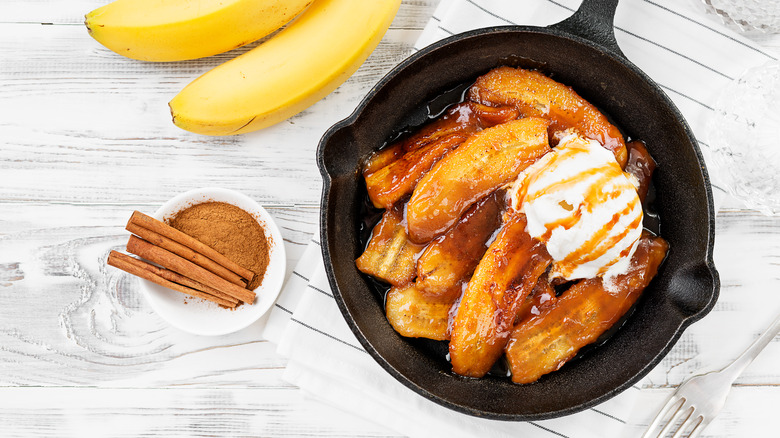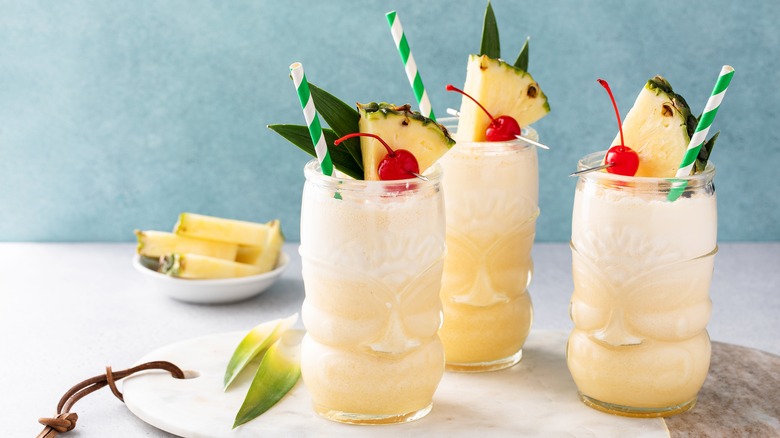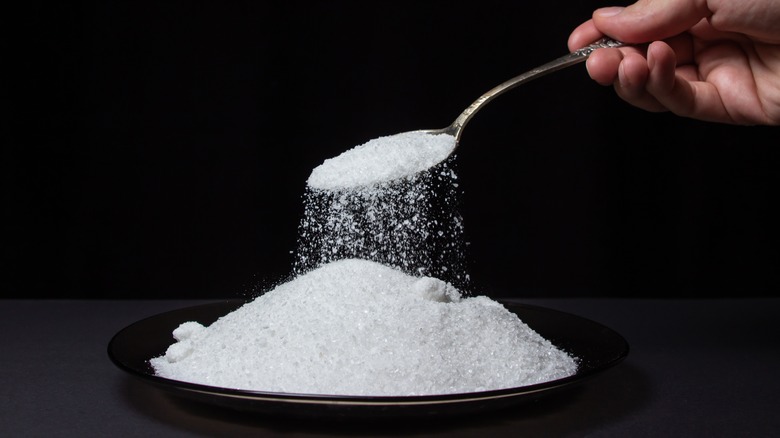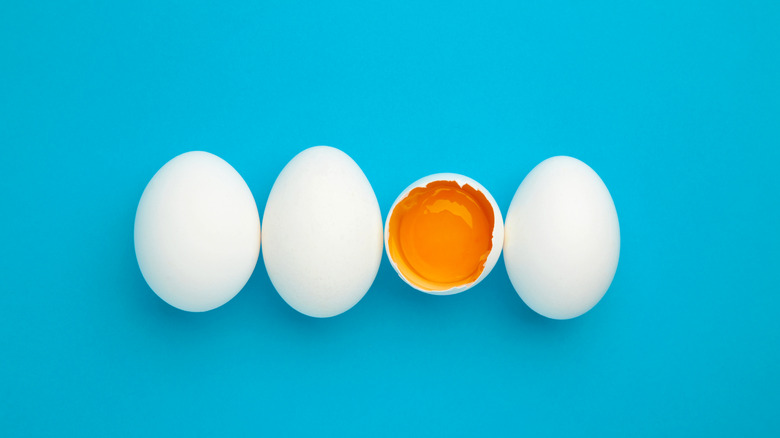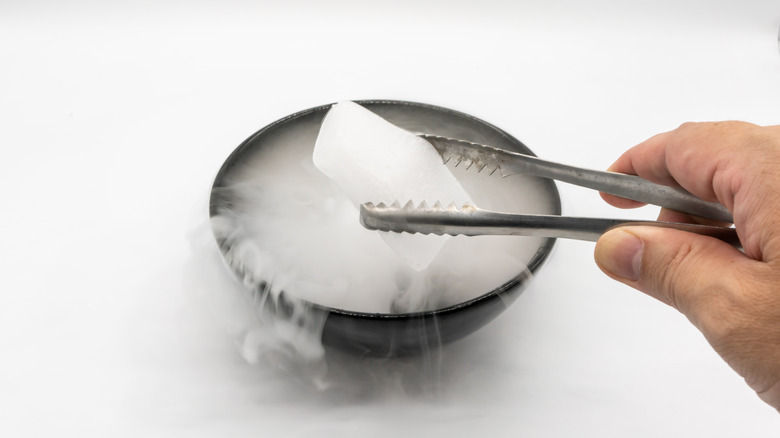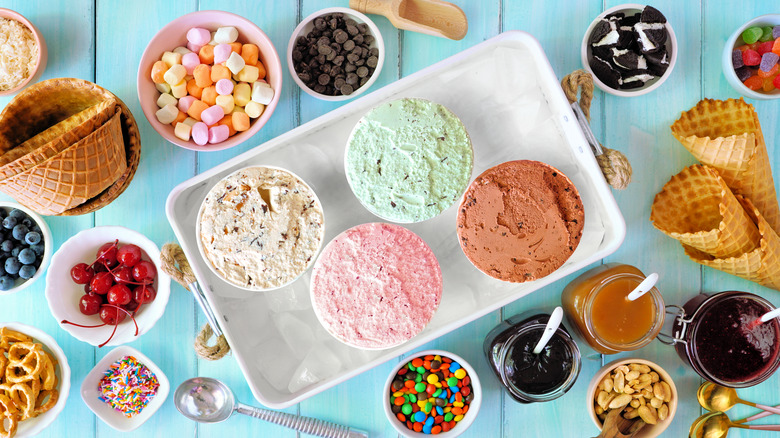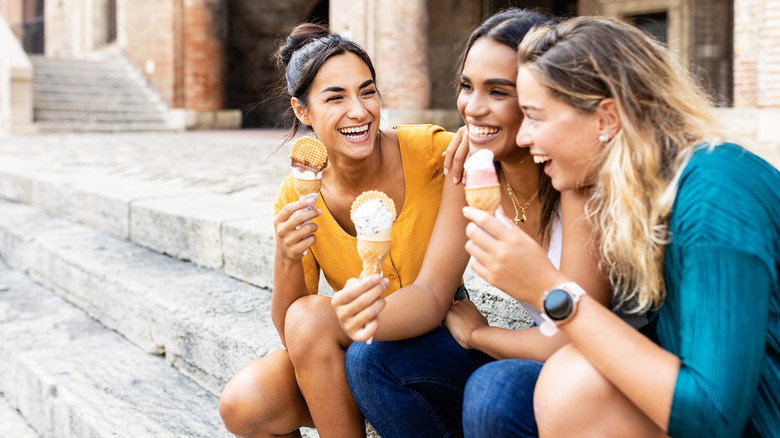The Biggest Mistakes You're Making With Boozy Ice Cream
There's nothing better than a fantastic scoop of ice cream. Unless, of course, you give it a grown-up twist with a little bit of booze. It blends a childhood treat with an adult indulgence, and if you're making ice cream at home, you can ensure that the ice cream — and the cocktail — are made exactly to your liking.
Whether you're using an at-home ice cream machine or opting for a no-churn method, homemade ice cream is a lot more accessible than you might think. "When you're making ice cream at home, try not to take it too seriously," says Melissa Tavss, founder of Tipsy Scoop — a liquor-infused ice cream brand with aptly-named ice cream "barlours" in Manhattan, Brooklyn, and Queens. "Let your boozy ice cream creative juices flow and have fun!"
Inspired by his father and grandfather before him, Tavss' great-grandfather had ice cream shops across the United Kingdom and was President of the Ice Cream Alliance of Great Britain. So it's no surprise she followed the family tradition (with a boozy kick, of course). She's been making alcoholic ice cream professionally since 2014, so we turned to her to learn how to avoid the biggest mistakes you're making with boozy ice cream.
Not knowing how alcohol affects ice cream
First things first: Alcohol is hard to freeze, which is why these tips are important. Alcohol does freeze, but the freezing point is different depending on the proof — which is why a can of beer might explode if you forget it in your freezer, but that bottle of vodka will happily hang out on the ice. If your freezer is set to 0 degrees Fahrenheit, a beer will freeze and explode in about 90 minutes, and wine will start to turn slushy after an hour. If a boozy slushy is your plan, pour the beer or wine into a plastic (not metal or glass) container with the lid ajar so there's room for the water content to expand as it freezes.
What does this mean for common mistakes you're making with boozy ice cream? Two things. "If you use too much [high-proof] alcohol, the ice cream won't freeze," Melissa Tavss explains. So you've got to be intentional with how much you pour in. On the other hand, though, adding alcohol can actually help keep your ice cream, well, creamy. "[Ice cream with alcohol] takes longer to freeze and melts quicker than normal ice cream." The result is ice cream with a more gelato-like consistency that will be easier to scoop straight from the freezer.
Choosing the wrong alcohol
A rich bowl of chocolate ice cream tastes amazing, but have you ever noticed that it doesn't smell like much? That is because cold foods release fewer smell particles than warm foods — which is why you can smell fresh brownies a mile away but might not know there's vanilla bean ice cream, too. So when you're adding alcohol to ice cream, it's important to choose types of booze that are flavorful enough to come through in your base even once it's chilled.
"Bourbon and whiskey have notes of vanilla and caramel, respectively, so they're perfect for including in desserts," says Melissa Tavss. Just like when you're making cocktails, an ice cream made with a darker liquor will be more spirit-forward in taste because it brings more flavor to the party. On the other hand, a neutral liquor is ideal when you want less of an alcohol flavor and want the flavors of the ice cream base to shine — think vodka in espresso martini ice cream.
Forgetting about aperitifs, amaros, and liqueurs
Vodka, tequila, and whiskey aren't the only alcoholic options available for boozy ice cream. If you're hoping to amp up the flavor, turn to liqueurs, aperitifs, and amaro, either on their own for a low-ABV kick or as part of a craft cocktail-inspired scoop.
"Liqueurs are also great for using in ice cream, and we often lean on them to impart a certain flavor in our ice cream or sorbet," says Melissa Tavss. At Tipsy Scoop, the team considers flavor profiles, "relying on limoncello to impart the lemon in our raspberry limoncello sorbet and crème de menthe for the mint in our spiked mint chocolate chip," according to Tavss.
Similarly, St-Germain would give vanilla ice cream a subtle, floral sweetness, while Campari or Aperol are begging to turn classic creamsicle ice pops into a next-level dessert. Even Nigella Lawson adds alcohol to her ice cream, using espresso liqueur to enhance the flavor of her no-churn coffee ice cream.
These ingredients will also help boost flavor when combined with other types of alcohol. Combine whiskey and Irish cream for Irish coffee ice cream, mix tequila and Cointreau for the true taste of a margarita, or pair crème de cassis and sparkling wine for a frozen Kir Royale. Talk about a flavor bomb.
Skipping wine and beer
Since wine and beer have a lower proof, they freeze at a higher temperature — which means they'll freeze solid in your freezer. It's not great if you forget the can you popped in for a quick chill, but it's awesome if you want an ice cream with a different flavor and a firmer texture.
As suggested by Melissa Tavss: "A rich chocolate stout is amazing in ice cream, and a crisp white wine or rosé is perfect in a refreshing sorbet." She recommends picking flavor pairings the same way you would pair a glass of wine or a bottle of beer with a dessert. Play to the flavors in your wine or beer, using an ice cream or sorbet base that will highlight the existing flavor profile.
Opt for something with a little sweetness that isn't too bitter, like a pumpkin or malty amber beer in vanilla ice cream or a fruity red or rosé with a strawberry base. Prosecco or Moscato would also be a great addition to bring out the light refreshment of sorbet.
Using too much (or too little) booze
Too much booze will prevent your ice cream from freezing. Using less will help your ice cream freeze. If you use too little, you won't be able to taste the alcohol over other flavors. The exact amount of alcohol to add will depend on your preferred booze.
"We've found that 5% ABV is the 'sweet spot,'" says Melissa Tavss. "The ice cream will freeze solid, and the alcohol flavor isn't too overpowering, but you can still discern the taste of the alcohol in the final product."
Once you know how much ice cream you're making and the ABV of your chosen spirit, you can use a simple formula to determine exactly how much to add. For 5% ABV when using a spirit like whiskey, vodka, or rum (usually around 40% ABV), you'll want the volume of alcohol to be around 12.5% of your total mixture. If your recipe makes a pint of ice cream, that's around 2 ounces of booze.
The ABV of wine or beer is lower, which means you'll need to use more to get the alcohol content you're looking for. For example, it would take nearly 6 ounces of 14% ABV wine to bring the ABV of a pint of ice cream to 5% — however, that significantly changes the makeup of your base. Your best bet is to start with a recipe (swapping in your preferred wine or beer to customize the flavor) before you begin exploring on your own.
Not balancing your flavors
When you're making boozy ice cream, remember that you're both a chef and a mixologist. "Your ice cream should taste like a well-mixed cocktail. Utilize complementing flavors like vanilla and bourbon, rum and coffee, citrus, and tequila," says Melissa Tavss. "The point isn't just to make the booziest ice cream you can; it's to create a flavor that's elevated by the inclusion of the spirit you choose — your final product should be the perfect combination of cocktail and dessert."
Like any good mixologist, you know that it takes more than one ingredient to make a cocktail, so it may take more than one spirit to transform your ice cream. Use elderflower or orange liqueur to add depth to a wine-based sangria sorbet, turn to both whiskey and sweet vermouth (plus some cocktail cherries) to create ice cream that tastes like a Manhattan, or pair crème de menthe and crème de cacao for a mint and white chocolate Grasshopper ice cream. You can even incorporate alcohol into ice cream like Ina Garten by adding Grand Marnier and Sauternes to peach ice cream to highlight the fruit's flavor.
"Make sure you carefully measure the amount of each spirit used so overall you end up with the amount of alcohol the recipe calls for," Melissa Tavss concludes. Per her reminders, too much alcohol will keep your ice cream from solidifying, and you should always taste test and adjust proportions prior to loading your ice cream maker.
Ignoring classic cocktails and desserts
Classic cocktails are classics for a reason, and that's a great place to get your inspiration. "Most of our core flavors are inspired by classic cocktails — mango margarita infused with tequila, strawberry white sangria infused with white wine," says Melissa Tavss.
Follow her lead and build ice creams based on drinks you already love. If you stan espresso martinis, add vodka and liqueurs to a coffee or chocolate ice cream base. Love a piña colada? A scoop of pineapple and coconut ice cream infused with rum sounds pretty perfect. And look beyond creamy cocktail creations. Pair cranberry-lime sorbet with orange liqueur and vodka for a scoopable Cosmo.
"Inspiration can also come from classic desserts," Tavss continues. To replicate apple pie, think about adding apple brandy to cinnamon ice cream and stirring in pieces of cooked apple and pie crust. Get all the goodness of Bananas Foster in a single scoop with rum and bananas in vanilla ice cream (bonus points for a swirl of caramel). And if chocolate is your love language, use coffee liqueur or espresso vodka to enhance the decadent chocolate flavor — just like you'd add espresso powder to make a chocolate cake pop.
Only making dairy-based ice cream
For those who love strawberry daiquiris and frosé, adding alcohol to sorbet is the next step (and means you'll have your favorite frozen drink on hand as long as the pint in your freezer lasts). In fact, adding alcohol to sorbet may be the perfect introduction to alcoholic ice cream.
Because alcohol has a lower freezing point, adding a little vodka to your lemon sorbet will help keep it scoopable instead of freezing rock-hard. Other crowd-pleasing pairings are gin and lime sorbet, rum with mango, and tequila with watermelon.
To make a silky ice cream without dairy, turn to coconut milk. "Non-dairy coconut milk bases also work well because they have a smooth, creamy, ice cream-like texture," says Melissa Tavss. Naturally, piña colada ice cream comes to mind, or incorporate additional fruit flavors for a Painkiller. Get inspired by your favorite dessert with a decadent coconut cream pie ice cream, or use coconut milk as the base for key lime pie ice cream that tastes like the tropics.
Skimping on the salt
Salt plays two very important roles in making ice cream. If you have a traditional ice cream maker at home, you've probably had to purchase ice cream salt to add to the basin filled with ice cubes. This salt lowers the freezing point of water. This allows the ice (and the water it melts into) to get colder than 32 degrees Fahrenheit, enabling your ice cream maker to properly chill the ice cream inside. This is a crucial change because it takes colder temperatures to freeze the fat and sugar in ice cream.
But you'll want salt in your ice cream mix, too. Since cold foods like ice cream are less fragrant, it takes more for the flavor to make itself known on your tongue. Instead of settling for bland ice cream, add enough salt to your base to help those flavors shine. Salt enhances sweet flavors (hello, salted caramel, and chocolate-peanut butter cups), and that salty-sweet pairing is perfect for ice cream.
Have you ever wondered why there's salt on the rim of your margarita and why that addition tastes so good? It's the same as adding salt to your dessert! Along with tempering the sweet ingredients in your cocktail, salt can also help mellow bitterness or contrast acidity. (The balance is similar to what you'd get from the pith of lime or the addition of bitters.)
Shunning stabilizers
If you want to make boozy ice cream that's scoopable without cutting back on the booze itself, consider a stabilizer. Eggs are the most common stabilizer used in ice cream; many homemade ice cream recipes call for a custard base made with egg yolks.
The magic of egg yolks in ice cream lies in what happens to egg yolks when they are cooked and when they are cooled. Yolks thicken as they cook (which is how your pot of mostly milk turns into a thick liquid before you chill it), but because they have such a high fat content, they freeze softer. This gives you the one-two punch of a thick texture that's soft enough to scoop.
Melissa Tavss likes to use guar gum, which is employed in a lot of commercial ice creams. "This will help with the texture, reduce ice crystal formation, and change the melting point," she explains. Guar gum comes from the guar bean, which is grown and eaten in Southeast Asia. Unlike thickening agents like cornstarch, guar gum still performs well in frozen products — which makes it an excellent choice for ice cream.
Guar gum in ice cream works by binding to water and preventing the forming of large ice crystals. This limits their molecular movement, creating a thicker texture and a rich, smooth mouthfeel.
Using an improper freezing technique
While adding alcohol to ice cream will impact how frozen your ice cream gets, it won't prevent ice crystals. This means if you don't use the proper technique, you'll wind up with icy slush instead of a smooth and scoopable final product.
Alcohol slows down the freezing process and lowers the freezing temperature of your base, so it's important to get boozy homemade ice cream super cold. If you're using a custard base, make sure you're putting it in an ice bath and getting it completely cold before churning. If you skip this step, your churning process will take way longer, and you'll actually encourage ice crystals to form as your ice cream maker tries to cool the hot liquid.
When it's time to churn, ensure your ice cream machine is properly chilled. A cold churn will freeze your ice cream faster, getting you to a creamy result quickly. Once your ice cream is churned, it's time to chill. "[Look for] any way that temperature can be reduced in the churning process or the setting process," says Melissa Tavss. "Use dry ice after it's churned to lower the temperature rapidly, [or] set your freezer to the lowest possible setting to help avoid ice crystal formation."
Forgetting to add mix-ins
Just like a great cocktail, great ice cream is about the whole experience. A garnish takes a cocktail to the next level through additional scents and flavors, and mix-ins in ice cream bring much-needed texture to an otherwise entirely creamy bite. Plus, it's a great way to bring home the cocktail-meets-ice cream experience.
Ice cream classics like Oreos, chocolate chips, marshmallows, and nuts would all be welcome — boozy Rocky Road, anyone? — if your goal is great ice cream with alcohol in it. But if you're coming at this project from the opposite direction and want to turn your favorite cocktail into ice cream instead of just adding booze, look to those cocktail garnishes instead.
A handful of chopped Luxardo cherries would really elevate a cherry ice cream that's the home to your favorite Manhattan. Fold in fresh fruit to add a juicy bite to sangria sorbet (because we all know the fruit left in your glass is the best part). And if you're using Frangelico, add chopped toasted hazelnuts to your ice cream — or maybe a few crushed pieces of Ferrero Rocher.
Trying to get drunk from boozy ice cream
Whether you're mixing a cocktail, pouring a glass of wine, or serving a scoop of boozy ice cream, it's important to have an idea of how much alcohol you're enjoying to keep everyone safe and healthy. But a few spoonfuls of ice cream aren't as easy to measure as a can of beer, so take an extra moment to consider just how boozy your ice cream is before adding that second — or third — scoop.
A pint of ice cream is generally considered to be four ½-cup servings (though Ben & Jerry's will tell you it's only three). If your homemade pint includes 2 ounces of hard liquor, that comes out to ½-ounce per serving — or ⅓ of a standard 1½ ounce shot. That means it would take 1½ cups of ice cream to serve a full shot of, say, vodka or whiskey and at least a pint to start feeling tipsy. If you want to transform your boozy ice cream into more of a cocktail, add it (and an extra shot) to a milkshake.
The good news? You'd probably get a stomach ache before you get drunk on boozy ice cream — making it the perfect adult after-dinner treat. Just make sure to label that container so any kids or non-drinkers don't get into it by accident, and scoop away!
